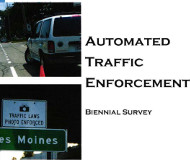8/21/2018
States Ignore Congressional Demand For Photo Enforcement TransparencyMost states refuse to follow federal law seeking accident and citation data from jurisdictions that use red light cameras and speed cameras on public roads.

Several states are defying a congressional demand for transparency regarding the use of red light cameras and speed cameras. The House and Senate in 2015 approved the FAST Act, a transportation funding measure that included a provision prohibiting the use of federal grants for automated ticketing equipment. The law also ordered the states with cameras to submit biennial reports containing "adequate data to measure the transparency and safety attributes" of these systems. A review of the state-level submissions showed few took the federal statute seriously.
The first set of reports submitted earlier this year confirmed an even split in the country. Twenty-five states (and five US territories) do not use red light cameras or photo radar compared to 25 states and one jurisdiction that do. In the latter group, Iowa was the most diligent in filing a 164 page report containing detailed statistics on the number of tickets issued, the number of crashes and the locations where the cameras were installed across each of the eight cities using photo enforcement.
Despite having one of the largest photo enforcement programs in the nation, Florida failed to file a report, and NHTSA incorrectly listed the Sunshine State among the jurisdictions without cameras. After being contacted by TheNewspaper, a spokesman for the Florida Department of Transportation explained that the agency would work to correct that oversight. Even without federal prodding, however, Florida has been producing a detailed report on the performance of the red light camera program. The 2017 report noted that total crashes, angle crashes and rear end crashes each increased 10 percent from before cameras were installed compared to after they began issuing tickets. Injury crashes increased 8 percent and serious injuries jumped 25 percent.
Most other states ignored the federal lawmakers' request for usable data. Oregon submitted a four-page document covering the eight cities using cameras. For each city, there is a table of information answering "yes" or "no" to the question of whether the city referred to federal guidelines when setting up the cameras. None of the jurisdictions answered "no." Other states put in even less work.
"It should be noted that the results reported in this document are based solely on the survey responses," the submission from Ohio's Traffic Safety Office explained. "There was no attempt made to independently verify the answers reported."
Only two jurisdictions -- Toledo and Newburgh Heights -- responded to Ohio's inquiry, and their answer was, "yes to all questions." Many other Ohio towns use photo radar, including East Cleveland, but the state made no attempt to encourage them to contribute to the federally mandated report.
"This survey is voluntary," Ohio wrote in its letter to towns using cameras. "The survey is one page is designed to minimize the time spent fulfilling all federal requirements."
California, likewise, refused to make an effort to properly survey the cities using cameras, despite paying the University of California Berkeley to contact the 43 cities still using cameras in the Golden State. The university sent a total of two emails to each city, only 17 of which responded. No further attempt at an official follow up was made. Over fifty California cities have dropped red light cameras in the past few years.
A copy of New Mexico's report is available in a 500k PDF file at the source link below.


